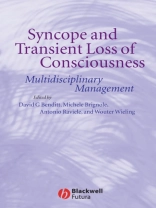Syncope is one of the most important causes of transient loss of
consciousness, and is such a common event that it may be
encountered by practitioners in virtually any field of medicine. As
such, a broad spectrum of healthcare professionals may be involved
in its assessment and management.
Edited by distinguished individuals whose pioneering work in
syncope highlights careers devoted to improving patient care, this
book provides:
* Succinct, practical and up-to-date guidance on the optimal
clinical evaluation and treatment of patients with syncope and
transient loss of consciousness in a multidisciplinary
framework
* Evidence-based recommendations founded on comprehensive
literature review and extensive clinical experience by expert
contributors
* Meaningful clinical tips for appropriate use of guidelines
in clinical practice
* Key recent citations
Building on the European Society of Cardiology Syncope
Guidelines, this book provides a clear evaluation of the latest
recommendations for care of patients with syncope and transient
loss of consciousness, with a multidisciplinary focus that makes it
equally relevant for general physicians or those specializing in
cardiology or neurology.
Mục lục
Contributors.
Preface.
Part 1 Syncope and TLOC overview.
1 Definition and classification of syncope and transient.
loss of consciousness.
Jean-Jacques Blanc.
2 Epidemiologic aspects of transient loss ofconsciousness/syncope.
Robert S Sheldon, Anna Serletis.
3 Pathophysiology of syncope: postural, neurally-mediated, .
and arrhythmic.
W Wieling.
4 Cerebral perfusion in syncope.
J Gert van Dijk, Roland D Thijs.
5 Risk stratification–impact on diagnostic strategy.
Brian Olshansky.
Part 2 Clinical evaluation strategies.
6 Value and limitations of clinical history in assessing causeof syncope.
Paolo Alboni, Maurizio Dinelli.
7 Emergency department evaluation of transient loss ofconsciousness/.
syncope.
Franc¸ois P Sarasin.
8 The essential autonomic assessment for evaluating the.
cause of syncope.
Carlos A Morillo, Juan C Guzman.
9 Neurally-mediated reflex syncope: recognition by historyand.
clinical testing.
Anna Serletis, Robert S Sheldon.
10 Value and limitations of ambulatory electrocardiographicmonitoring.
Andrew D Krahn.
11 Recording ambulatory blood pressure in the syncope and.
TLOC evaluation.
Dietrich Andresen.
12 Electrophysiologic testing: value and limitations in thetransient loss of.
consciousness/syncope evaluation.
Suneet Mittal.
13 Intolerance to upright posture in autonomic failure and thepostural.
tachycardia syndrome: assessment and treatment strategies.
Christopher J Mathias.
14 Improving tolerance to upright posture: current status oftilt-training.
and other physical maneuvers.
Hugo Ector, Tony Reybrouck.
15 Syncope in patients with bundle-branch block and otherconduction.
system abnormalities.
Angel Moya.
Part 3 Specific conditions.
16 Treatment strategies in neurally-mediated reflex syncope:effectiveness of.
drugs, pacing, and physical maneuvers.
Richard Sutton.
17 Structural heart disease, syncope, and risk of sudden death:selection of.
patients for implantable cardioverter-defibrillator therapy.
Kathy L Lee, Hung-Fat Tse, Chu-Pak Lau.
18 Channelopathies as a cause of syncope.
T Boussy, Pedro Brugada.
19 Distinguishing seizures and pseudosyncope from syncope.
Adam P Fitzpatrick.
20 Syncope and transient loss of consciousness in children andadolescents:.
congenital and acquired conditions.
Hugh Calkins.
21 Transient loss of consciousness, syncope, and falls in theelderly.
Rose Anne Kenny.
22 Drug-induced (iatrogenic) syncope.
Gerald V Naccarelli.
Part 4 Economic and research aspects.
23 Syncope and the competitive athlete: recommendations forevaluation.
and permission to compete.
Franco Giada, Antonio Raviele (Ospedale Umberto I).
24 Role of syncope management units.
Win K Shen, Michele Brignole (Ospedali del Tigullio).
25 The impact of syncope and transient loss of consciousnesson.
quality of life.
Blair P Grubb.
Part 5 Current controversies and future directions.
26 Driving and flying restrictions for the syncope and/orimplanted.
cardiac device patient.
Christina M Murray, Dwight W Reynolds.
27 Clinical trials landscape: what’s new, what’songoing, what do.
we need.
Michele Brignole (Ospedali del Tigullio), David G Benditt(University of Minnesota Medical School), Wouter Wieling (Academic Medical Centre).
28 Syncope and transient loss of consciousness:multidisciplinary.
management.
A John Camm.
29 Syncope practice guidelines initiative.
David G Benditt (University of Minnesota Medical School).
Appendix: syncope consortium members.
Index












